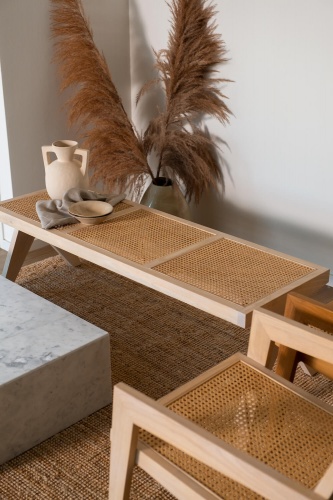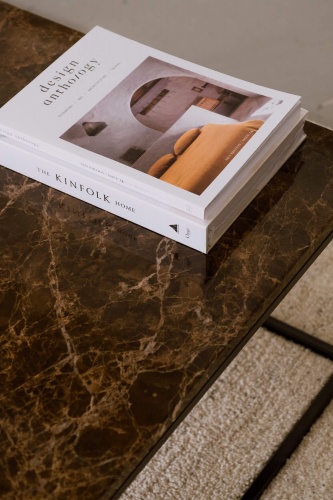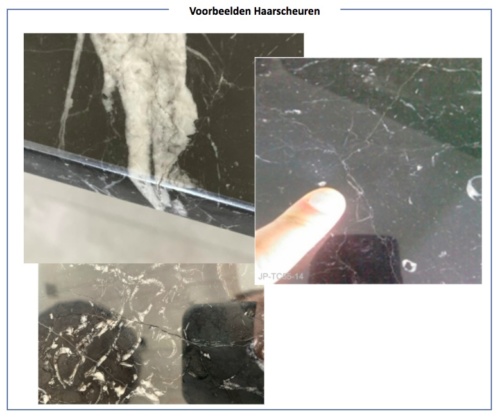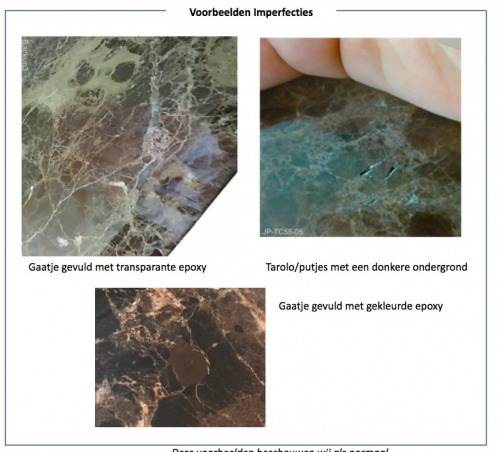About Marble
Since ancient times, marble has been used to build and decorate palaces, churches, sculptures and squares. From the temples on the Acropolis and Michelangelo’s sculptures to the Taj Mahal in India and the Sacré-Cœur in Paris… centuries on, they are just as strong and majestic. Marble is a very strong natural product with a luxurious appearance and a beautiful, almost transparent incidence of light.
Extracting marble is a tough job, but the hardest and most impressive work is done by Mother Earth herself. Due to constant shifts in the earth’s crust, limestone gradually metamorphoses into marble. Each pattern is formed organically, making it completely unique: custom made by Mother Earth. The enchanting dance of ornamental veins, the seductive colour nuances and the characteristic crystal structure make this natural stone an ultimate luxury product.


Our marble types
Although the name ‘marble’ originates from Greece, it is actually used all over the world. Each region has its own name and distinctive colour. The types of marble we work with are:
- Bianco Carrara white – Italy
- Nero Marquina black – Spain
- India Green green – India
- Dark Emperador brown – Spain
- Crema Marfil beige – Spain
Find out about the characteristics of marble and how to care for it below.
Characteristics
What are the characteristics of marble?
Marble is composed of calcium carbonate, which is why this natural stone is sensitive to scratches and stains. Marble has a crystal-like structure that is especially visible at the fracture surface. The various colour nuances and veins vary per marble region. Marble adds a calm, soft, natural look to the home, which combines well with other natural elements and warm natural tones.
Marble is sensitive to acidic liquids such as vinegar, lemon juice and fruit juice that tarnish the surface. Water can also cause rings. We therefore recommend keeping the table dry and always using coasters. Liquids can cause permanent stains due to the porosity of marble. The porosity also makes marble a poor conductor of heat, meaning it always stays cool. That is why marble is popular with bakers and confectioners: its cool surface prevents their dough from overheating. Marble does not cope well with heat either. Do not place pans or unprotected glasses containing hot liquids on the marble as this can cause dull spots.
Natural imperfections
As a natural product, marble is imperfect by definition. There are often imperfections and superficial fossils in the top even after it has been polished. Be careful not to confuse these imperfections with actual damage to the top. You might discover small cracks, holes or rough spots in the marble (also called ‘taroli’). This does not pose any risk to the quality and durability of your table.
Common imperfections
Every type of stone has its own common imperfections. You can find out more about this below under ‘Marble imperfections’.
Maintenance
How do I take care of my marble table?
The table has a glossy polish layer that provides protection. Nevertheless, we recommend that you treat the top with impregnation agent. This treatment gives the table an additional protective layer against acids, moisture and dirt. Always follow the instructions on the label. We also recommend using coasters and placemats to protect your table.
Repeat the impregnation treatment every two months by applying at least one layer of new impregnation agent. This will give your table maximum protection.
Superficial scratches may also occur during normal use. As with wooden tables, we recommend that you have the table polished once in a while. This will keep your table looking just like new.
How do I clean marble?
When cleaning, avoid using aggressive acidic agents such as Glassex, Dreft and damp cleaning cloths. Use green soap or a natural stone cleaner instead. Do not use a scourer to clean the table and never rub too hard as this can cause scratches. Also make sure that there is no water residue by using a slightly damp cloth and immediately wiping the table with a dry cloth afterwards.
For regular maintenance, you can use the special marble cleaner included in our care kits. You do not need to use this cleaner daily. This cleaner is not suitable for removing stains in marble; we offer other products for this purpose.
What do I do if there is a stain on my marble?
Marble is a porous natural stone. Acids and liquids can cause dull stains and rings if allowed to soak in. We therefore recommend that you always use coasters and placemats and wipe the table immediately using a damp cloth in the event of spills. We also advise periodically treating the table with impregnation agent to protect the table ever better.
For advice on stain removal, please contact our Customer Service department.
Useful information
Nero Marquina marble is extra sensitive
Black marble tables are more sensitive to stains than other types of marble. That is why you should impregnate the table with the recommended products before use. We offer a special care kit for Nero Marquina black marble for this purpose
Even once you have treated the table, stains can occur and acidic substances will always cause stains. This can happen in as little as 10 to 30 seconds, so take care when it comes to using and caring for your marble on a daily basis. If stains appear, our Customer Service department can advise you on how to treat them.
Difference between polished and honed marble
Our marble tables are delivered polished as standard. The polish layer is the shiny finish that enhances the colour intensity and gives the marble an initial protective layer. Our marble blocks are delivered honed as standard, which is a matte finish. The difference is in the final look that the finish produces. Honed marble is also slightly more sensitive to stains and scratches than polished marble and therefore requires treatment with a special impregnation agent.
Can I place marble outside?
Our dining tables are not suitable for outdoor use. However, by popular demand, we will shortly have a new collection of garden tables! Besides marble garden tables, we will also have a range of granite garden tables. Both are perfectly suitable for the outdoors. Take a look at our outdoor collection soon: garden tables
Marble imperfections
Carrara Bianco
White Carrara from the quarries of the Apuan Alps in Tuscany is a very durable marble characterised by an off-white or light grey background and striped veins or small dark grey holes. Its chemical composition is 99% calcium carbonate, which makes it very solid, but it can still be affected by acids. The surface may show areas with concentrations of intense white quartz crystals of about 1-6cm in size, called ‘ghiacciolo’ (ice).
Another feature that can appear in Bianco Carrara are ‘taroli’, which are small craters on the surface of the marble and are the natural result of the crystallisation of calcium carbonate. It can be up to several millimetres in diameter.
As it is a natural material, these ‘imperfections’ must be considered as proof of the authenticity of the material and of the intrinsic and essential characteristics of the marble.
This is considered normal:
- Crystal formation: acceptable in any shape or size and does not cause cracks.
- Taroli/small holes: acceptable if they are less than 5mm in size and if the concentration in the piece is not excessive.


Nero Marquina
Black marble from Spain with white veins that can vary from a few millimetres to a few centimetres in size or even go unnoticed.
This marble was formed by the sedimentation of sea molluscs and fossils.
The presence of small cracks on the surface of the marble forces the surface to be covered in transparent or black resin in order to saturate as many of these material deficits as possible. They will always be visible on the surface – even if they are well filled with resin – because polishing removes the superficial part of the resin.
The surface always shows micro cracks, which are intrinsic characteristics of the material and a proof of authenticity. Micro cracks are visible and you can feel them with your finger, but they will not cause cracks in the artefact.
The very brittle nature of marble means that producers have to reinforce the slabs with gauze and glue on the underside.
This is considered normal:
- Presence of fossils and white (or sometimes yellow) shells in the black background
- Small cracks on the surface of the table, which can run across the entire width or thickness of the table
- Resin-bonded micro cracks no wider than 2mm (they would otherwise be considered cracks)
- Absence or excess of white veins, as these can suddenly vary within the same block
- Small holes filled with transparent or black resin smaller than 10mm
Dark Emperador
Dark Emperador is a marble from Spain and consists of small stones (gravel) measuring a few centimetres in size that are connected by calcium carbonate. Due to its properties, there may be cavities in the material. It can have brown shades varying from light to very dark with white crystals. The very brittle nature of marble means that producers have to reinforce the slabs with gauze and glue on the underside and saturate the holes in the surface with brown or transparent resin. Any cracks are also filled with resin.
This is considered normal:
- Small holes filled with epoxy: no larger than a €2 coin, coloured or transparent
- Small cracks that you can feel with your finger
- Changes in shades of light and dark brown



